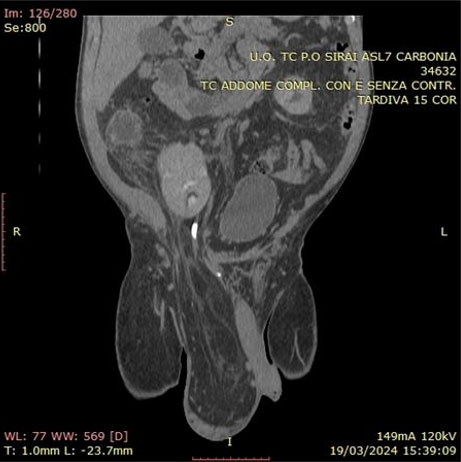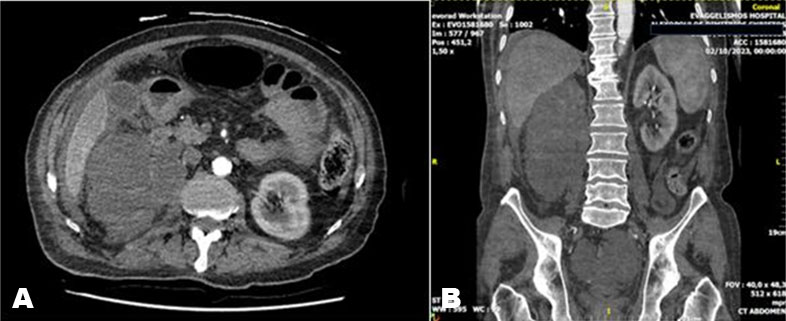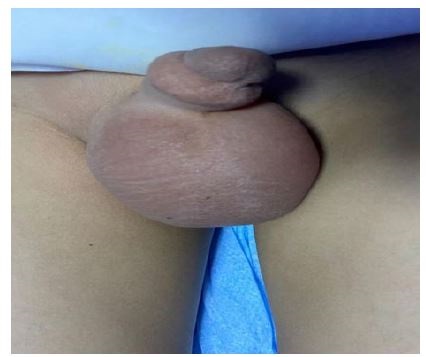 |
Case Series
Prenatal diagnosis of genital anomalies with MRI: A case series
1 Postdoctoral Researcher, Pediatric Urology Research Enterprise, Department of Pediatric Urology, Children’s Hospital Colorado, Aurora, CO, USA; Division of Urology, Department of Surgery, University of Colorado School of Medicine, Aurora, CO, USA
2 Resident Physician, Department of Urology, University of Utah School of Medicine, Salt Lake City, UT, USA
3 Resident Physician, Department of Anesthesiology, University of California San Diego School of Medicine, La Jolla, CA, USA
4 Associate Professor, Department of Pediatric Radiology, Children’s Hospital Colorado, University of Colorado School of Medicine, Aurora, CO, USA; Director of Fetal Imaging, Children’s Hospital Colorado, Colorado Fetal Care Center, Aurora, CO, USA
5 Professor, Pediatric Urology Research Enterprise and Colorado Fetal Care Center, Department of Pediatric Urology, Children’s Hospital Colorado, Aurora, CO, USA; Division of Urology, Department of Surgery, University of Colorado School of Medicine, Aurora, CO, USA
Address correspondence to:
Towela King
MD, Children’s Hospital Colorado, University of Colorado School of Medicine, 13021 E. 21st Ave, Aurora, CO 80045,
USA
Message to Corresponding Author
Article ID: 100053Z15TK2025
Access full text article on other devices

Access PDF of article on other devices

How to cite this article
King T, LaCouture H, Jiménez DS, Meyers ML, Vemulakonda VM. Prenatal diagnosis of genital anomalies with MRI: A case series. J Case Rep Images Urol 2025;10(1):17–23.ABSTRACT
Introduction: Fetal magnetic resonance imaging (MRI) is commonly used as an adjunct to prenatal ultrasound (US) in identifying genitourinary abnormalities, but there is no data regarding its accuracy when identifying genital anomalies. To address this gap, this study reviewed our experience with identification of genital anomalies on fetal MRI and the correlation between fetal MRI findings and postnatal diagnosis.
Case Series: An Institutional Review Board (IRB) approved retrospective review was conducted for patients with genital abnormalities noted on fetal MRI. Patients were excluded if the anomaly required no perinatal management steps, such as an isolated foreshortened phallus or due to an unrelated anomaly such as bladder exstrophy. The data collected included patient and maternal demographics, gravida status, prenatal ultrasound and fetal MRI findings, postnatal diagnosis, early postnatal course, and subsequent management. In this series of five patients with clinically significant genital findings on fetal MRI, two patients’ fetal MRI findings were confirmed by postnatal physical exam and/or imaging. Among the two patients with hypospadias in this series, only one was correctly diagnosed on fetal MRI and received postnatal follow-up by urology. Ambiguous genitalia were read in three patients’ fetal MRI with one of those confirmed postnatally. Two of these three patients underwent early rule-out congenital adrenal hyperplasia based on fetal MRI.
Conclusion: A low percentage of patients with genital abnormalities received accurate prenatal diagnosis by fetal MRI. Fetal MRI may not provide an accurate diagnosis for prenatally detected genital findings but may serve as an additional data point to inform early postnatal diagnostics and level of care for patients with syndromic findings, such as ambiguous genitalia associated with congenital adrenal hyperplasia.
Keywords: Fetal magnetic resonance imaging (MRI), Genital anomalies, Genitourinary radiology, Obstetric radiology, Pediatric urology, Prenatal ultrasound
SUPPORTING INFORMATION
Author Contributions
Towela King - Conception of the work, Design of the work, Acquisition of data, Analysis of data, Drafting the work, Revising the work critically for important intellectual content, Final approval of the version to be published, Agree to be accountable for all aspects of the work in ensuring that questions related to the accuracy or integrity of any part of the work are appropriately investigated and resolved.
Hunter LaCouture - Conception of the work, Design of the work, Acquisition of data, Analysis of data, Drafting the work, Revising the work critically for important intellectual content, Final approval of the version to be published, Agree to be accountable for all aspects of the work in ensuring that questions related to the accuracy or integrity of any part of the work are appropriately investigated and resolved.
Daniel Soria Jiménez - Conception of the work, Design of the work, Acquisition of data, Analysis of data, Drafting the work, Revising the work critically for important intellectual content, Final approval of the version to be published, Agree to be accountable for all aspects of the work in ensuring that questions related to the accuracy or integrity of any part of the work are appropriately investigated and resolved.
Mariana L Meyers - Conception of the work, Design of the work, Acquisition of data, Analysis of data, Drafting the work, Revising the work critically for important intellectual content, Final approval of the version to be published, Agree to be accountable for all aspects of the work in ensuring that questions related to the accuracy or integrity of any part of the work are appropriately investigated and resolved.
Vijaya M Vemulakonda - Conception of the work, Design of the work, Acquisition of data, Analysis of data, Drafting the work, Revising the work critically for important intellectual content, Final approval of the version to be published, Agree to be accountable for all aspects of the work in ensuring that questions related to the accuracy or integrity of any part of the work are appropriately investigated and resolved.
Guaranter of SubmissionThe corresponding author is the guarantor of submission.
Source of SupportNone
Consent StatementWritten informed consent was obtained from the patient for publication of this article.
Data AvailabilityAll relevant data are within the paper and its Supporting Information files.
Conflict of InterestAuthors declare no conflict of interest.
Copyright© 2025 Towela King et al. This article is distributed under the terms of Creative Commons Attribution License which permits unrestricted use, distribution and reproduction in any medium provided the original author(s) and original publisher are properly credited. Please see the copyright policy on the journal website for more information.





